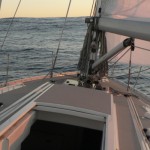This article is a follow-up from Heavy Weather Dynamics: Yachts in Following Seas published some months ago. It has since become one the most read items on this site. While the original article applied to most sea-going monohulls, the following discusses more specifically fast modern hulls, or yachts in very fast following seas, such as can […]
Design
Marine design
Heavy Weather Dynamics: Upwind Sailing, Windage and Resistance
With tropical cruising becoming increasingly popular and accessible in the last 2-3 decades, trends have developed in outfitting yachts for ocean cruising. Some of these trends that originated from sailing in moderate settled weather areas have resulted in significantly increased risks when a vessel is caught in severe conditions. Many of today’s cruising yachts, whether […]
Heavy Weather Dynamics: Yachts in Following Seas
This article deals with some of the physics involved when a yacht is running before the sea, especially in heavy weather when waves are long and their front faces become steep. Yachts running in heavy weather and following seas face challenges that are very dependent on the characteristics of the design; the ability of the crew […]
The 1885 Presto Hull Design
The Presto design was developed by Commodore Munroe in the 1880s on the US Atlantic Coast. The boats sailed up and down the coast some distance offshore and were confronted by the frontal weather systems and the influence of the Gulf Stream found in that part of the world. The first time I came across […]
Transverse Stability, Part 4: Sailing Yachts at Sea
This article follows Transverse Stability, Part 3: Dynamic Stability Part 3 of this series dealt with changes in transverse stability taking place once a vessel starts travelling through the water. This article discusses the way the stability of sailing yachts can be challenged at sea as a result of wave action. Wave action doesn’t reduce […]
Inverted Stability: Once Upside Down
Inverted stability applies when a yacht remains upside down. It is a rare, but not unknown event and one situation where some understanding of yacht design and stability can become of crucial importance at sea. Two main scenarios lead to capsize: Loss of the keel or ballast Yacht rolled by a breaking sea and remaining […]
Transverse Stability, Part 3: Dynamic Stability
This article follows Transverse Stability, Part 2: Stability Curve and Knock-Down Energy If you are looking for information regarding the stability of monohull yachts hit or capsized in beam seas, the subject is treated in the next part, Transverse Stability, Part 4: Sailing Yachts at Sea. In the case of monohulls, regardless of the type […]
Design Overview
The sloop Nordkyn is a 13-metre (43′) round-bilge alloy yacht with a displacement of about 8600kg half-loaded in cruising trim. It features a fixed bulb keel with a draft of 2.35m (7′ 9”) and a single deep spade rudder. The alloy construction is very robust without being heavy and the deck is integral to the aluminium […]
Offshore Weather: Sailing Near the Limit
Sailing over 55,000NM in seven years on board the 9-metre sloop Yarra between the Arctic and the Antarctic resulted in a fair share of strong winds and rough seas at times. I managed to wear a set of hanks on my storm jib and pull my new #2 jib out of shape. Even so, wind […]
Development
Hull shape is the largest contributor to success or failure in yacht design. Appendages can be replaced, rigs modified, but a bad hull is usually where the buck stops. It is just as true for motor vessels. The design of the Nordkyn hull was underpinned by two key objectives: exceptional seakeeping properties and excellent light […]










